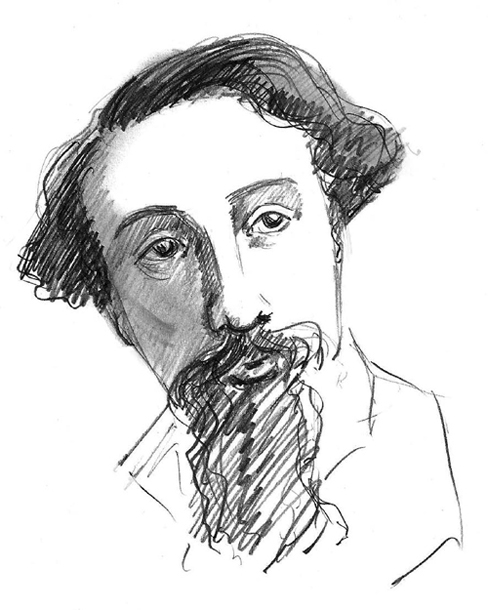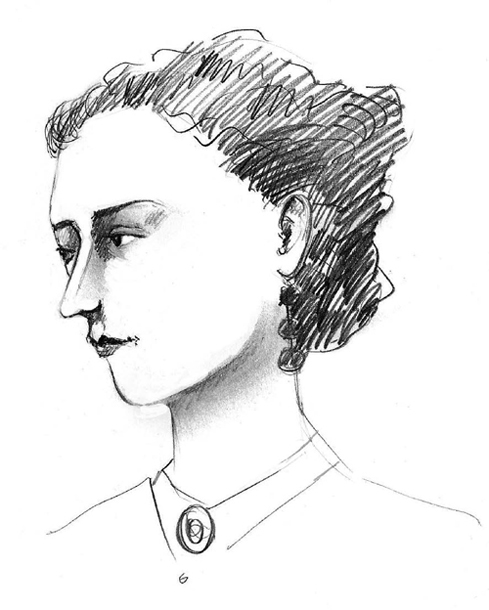Other Women (18 page)
Authors: Fiona McDonald

Throughout the world and throughout time artists have found the need for inspiration to help them achieve their greatest works. Artists today may well tell you that hard work is an excellent form of inspiration and that you need to grab it by the throat not wait for it to float down from on high. It is true though that artists, whether they are musicians, painters or writers, do respond better to certain stimuli over others. The traditional source of inspiration is the beautiful woman, particularly for visual artists. It has been such a constant source of artistic expression that Greek mythology named it in terms of goddesses: the Muses. The word muse has stuck and a human female will sometimes captivate an artist to such an extent that the creative juices cannot flow without it.

LLEN
‘N
ELLY
’ L
AWLESS
T
ERNAN
THE INVISIBLE MISTRESS
O
F
C
HARLES
D
ICKENS
Charles Dickens is a name everyone knows. His stories are admired the world over, as much today as they were in his own time. There has never been any doubt that he had a vivid imagination, boundless creative energy and was a character fit for one of his own novels (and indeed several of his books had strong autobiographical elements). He was married for many years to Catherine (
née
Hogarth), with whom he had ten children. Dickens built up a reputation as being a family man and that children and loyalty in marriage were very important. And for a long time they were, until Charles Dickens, at the age of 45, fell desperately in love with a young woman who was roughly the same age as one of his daughters. Infatuation made Dickens become ruthlessly cruel to his faithful wife and extremely secretive about his love for the young woman. Although Dickens was adamant he was not having an affair with another woman he couldn’t help himself from dropping huge incriminating hints about it. He knew that if word got out that he had taken a mistress it could devastate his reputation and his livelihood.
Dickens was in his mid-40s at the time of writing
The Frozen Deep
and was beginning to find his long-time marriage to Catherine uninspiring. Catherine, after so many years of childbearing, was growing stout and homely.
Who was this mysterious young woman? In 1857 Dickens engaged a number of professional actors to perform
The Frozen Deep
with him, a play that he had helped co-author with his friend Wilkie Collins. Among the thespians were a well-known but semi-retired actress and two of her daughters. It was one of these two young ladies who caught Dickens’s attention and ultimately stole his heart.
When Dickens had been a teenager himself he had fallen deeply in love with an intoxicatingly pretty young woman called Maria Beadnell. For a long time after Dickens’s death nothing was really publicly known about Maria and her part in the young Dickens’s life. Just after the turn of the twentieth century an American collector of curios, Mr William K. Bixby, came across a bundle of letters containing Dickens’s signature. The bundle turned out to contain two lots of letters to the one woman, but years apart. The first group were letters by a teenage Dickens to a young lady named Maria Beadnell, the second group were to the same lady but to her married, middle-aged self Maria Winter.
The letters could not be published in Britain at that time because of the copyright laws. Mr Bixby took the letters home across the Atlantic and handed them over to the Bibliophile Society to have 493 copies of them made, all to contain the society’s book-plate. These were to be distributed to members of the society. Several other copies were made and these were placed in the Congress Library in Washington.
The bulk of the early letters show Dickens as a would-be suitor pouring his heart out to Miss Maria Beadnell. For a while Maria seemed to enjoy his attention and encouraged him. After a stint abroad, however, Maria spurned Dickens and broke his heart. Maria became the inspiration for the delicate, impractical and demanding character of Dora, who becomes the needy wife of David Copperfield in the novel of the same name. Maria Beadnell may well have been the author’s first muse. The second bundle of letters were written after Dickens and a married Maria Winter made contact again some twenty years later.
In 1836 Dickens married the much more sensible Catherine Hogarth. They began life together with Catherine’s younger sister Mary coming to live with them. The following year Dickens held Mary in his arms as she was dying. He had idolised her. The depth of Dickens’s mourning led to him taking a ring from her dead finger and wearing it on one of his own for the rest of his life, keeping a bundle of her clothes and letting her spirit enter a number of his poignant characters: little Nell being among the most obvious. Mary Hogarth, with her youthful freshness and vivacity, her imagination and willingness to be entranced by her brother-in-law’s stories and wit, was the perfect muse for the writer, especially as she was never to grow old.
In 1842 Mary Hogarth was replaced by another of Catherine’s sisters, Georgina. She too came to live with the Dickens family when she was 16. This was the year that Charles and Catherine went to the United States for Dickens’s first lecture tour. Georgina was left at home to look after the couple’s four children. In 1843 Dickens wrote a letter to his mother-in-law asserting that Georgina was the spirit of Mary returned to them. Georgina became the new muse in Dickens’s life. Perhaps, as Georgina passed into mature womanhood, although she didn’t grow matronly as her older sister did, she nevertheless lost some of her angelic loveliness.
In 1855 Maria Beadnell resurfaced in Dickens’s life. She wrote him a letter, and he enthusiastically responded. They exchanged a number of letters talking about their youthful friendship, Dickens certainly implying that he had deeply loved her. Maria answered that she too had been in love with him but that she had been prevented from following her passion by her family. The brief correspondence led to a meeting, what was probably going to be a secret assignation in Dickens’s mind, between himself and his first true love. To be fair, Maria had warned him that she was no longer the slim beauty he had known over twenty years ago. Dickens was not going to be put off by what surely must be modesty. Yet he was in for a shock. Maria, nearly 45, was indeed a portly, middle-aged woman. Dickens did not try to conceal his disappointment. Maria, hoping that there might yet be an old spark to reignite the amorous flame, continued writing to him but Dickens’s replies grew cold and he evaded making a commitment to seeing her again. Instead he immortalised the older Maria in the form of Flora Finching in
Little Dorrit
, just as he had done her young self in
David Copperfield
. Another muse had bitten the dust.

Charles Dickens
By the time Dickens met Ellen Ternan he was again in need of that sweet, adolescent muse that could help stimulate memories of Mary Hogarth.
Ellen ‘Nelly’ Ternan (1839–1914) was born in Rochester, Kent into a theatrical family, the youngest of three girls. There had been a brother but he had died as a baby. Ellen’s mother, Frances Ternan,
née
Jarman, had played with such notable actors as Edmund Kean and Charles Kemble. Thomas Ternan, Nelly’s father, had died in 1846, with hardly a penny to his name. The bereft family came under the protection of William Charles Macready, a long time friend of Dickens.
When Dickens met Nelly, she had been acting for some fifteen years already. She and her sisters had been introduced to the stage in their early childhood and had been presented as an ‘infant phenomena’. Maria, the sister next to Nelly in age, was showing great promise in comedy theatre and singing. Fanny, the eldest of the girls, was playing Oberon in a production of a
Midsummer Night’s Dream
at the Princess Theatre at the time Dickens engaged the rest of the family to play in
The Frozen Deep
for a performance at the Manchester Free Trade Hall. Nelly had just finished playing her first adult role on stage, that of Hippomenes in a satire by Frank Talfourd at the Haymarket Theatre. Nelly had found it difficult to shake off the reputation of herself as a child prodigy and the recurring roles that this offered.

Ellen ‘Nelly’ Lawless Ternan
The Frozen Deep
was inspired by reports by the Scottish surveyor John Rae, of evidence of cannibalism among the members of the Arctic expedition of Sir Charles Franklin that had left England in 1845 never to return. The play was an allegorical denial of this supposed barbaric fate. Dickens had started helping Wilkie Collins to write the play in 1856, at least he maintained that he was just altering a line or two here and there, though in reality a fair bit of it is the work of Dickens and not Collins. Dickens was outraged at the suggestion that Franklin and his men would resort to something as barbaric, as un-English as eating one another, no matter if they were starving.
Frances Ternan played Nurse Esther, Maria had the main female role of Clara Burnham and Nelly was given a minor part as Lucy Crayford. The cast was initially gathered together for three days of intensive rehearsals in Dickens’s own home, Tavistock House. From there they travelled as a company, taking the train to Manchester and boarding at the same hotel.
The little company gave three performances of the play at the Free Trade Hall in Manchester, the proceeds from ticket sales going directly into a charitable fund to aid the widow and family of Dickens’s long-time friend Douglas Jerrold. The event raised £2,000 (around £117,000 today) and brought the audience to a torrent of tears. Dickens was elated by his success (not only with the play but with his own performance).
However, after the adrenalin rush from the play’s triumph, Dickens began to display a restlessness unlike any he had previously shown. It manifested itself with the need, as he suggested himself, to climb high mountains. Surely this was a strong symptom of being hopelessly in love.
It was unclear for some time as to which of the two Ternan sisters was the object of his desire, until he wrote of little lilac gloves and golden hair: Nelly was the blonde. Dickens felt he had found his muse in the young woman, only a little older than his own daughter Katie. The more he seemed to think about Nelly the more he seemed displeased with his frumpy old wife. Catherine took the blame for all her husband’s unhappiness; she was unimaginative, she had no creativity, she didn’t understand his needs.
Dickens tried to allay some of his restlessness by going on a walking tour with his friend Wilkie Collins; their adventures would be written up in
Household Words
in a piece called ‘The Lazy Tour of Two Idle Apprentices’. While he was away Dickens wrote only to his sister-in-law Georgina and not at all to his wife, which was rather unusual in itself. He ignored Catherine entirely in his letters to her sister, although he sent his love to all the children. When the walking tour was over (ending with Collins falling over and spraining his ankle) the pair travelled straight to the races at Doncaster where Dickens had already booked them accommodation. Coincidentally, the Ternan girls were going to be there and he couldn’t help but bump into them.
